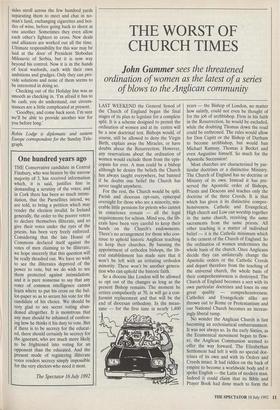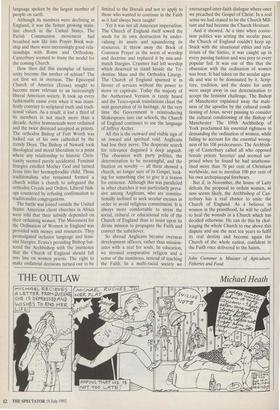THE WORST OF CHURCH TIMES
John Gummer sees the threatened ordination of women as the latest of a series of blows to the Anglican community
LAST WEEKEND the General Synod of the Church of England began the final stages of its plan to legislate for a complete split. It is a scheme designed to permit the ordination of women and at its centre will be a new doctrinal test. Bishops would, of course, still be allowed to deny the Virgin Birth, explain away the Miracles, or have doubts about the Resurrection. However, any reservations about the ordination of women would exclude them from the epis- copate for ever. A man could be a bishop although he denies the beliefs the Church has always taught everywhere, but banned if he doubts one belief the Church has never taught anywhere.
For the rest, the Church would be split. Parish and diocesan opt-outs, episcopal oversight for those who are a minority, mis- erable little pensions for priests who cannot in conscience remain — all the legal requirements for schism. Mind you, the lib- erals have been very careful to keep their hands on the Church's endowments. There's no arrangement for those who con- tinue to uphold historic Anglican teaching to keep their churches. By banning the appointment of orthodox bishops, the lib- eral establishment has made sure that it won't be left with an irritating orthodox minority. There won't be another genera- tion who can uphold the historic faith.
So a diocese like London will be allowed to opt out of the changes as long as the present Bishop remains. The moment he retires compulsorily at 70, in will go a con- formist replacement and that will be the end of diocesan orthodoxy. In the mean- time — for the first time in nearly 1,400 years — the Bishop of London, no matter how saintly, could not even be thought of for the job of archbishop. Firm in his faith in the Resurrection, he would be excluded, while the doubting Thomas down the road could be enthroned. The rules would allow for Don Cupitt or the Bishop of Durham to become archbishop, but would ban Michael Ramsay, Thomas a Becket and even Augustine himself. So much for the Apostolic Succession!
Most churches are characterised by par- ticular doctrines or a distinctive Ministry. The Church of England has no doctrine or Ministry of its own. Instead it has pre- served the Apostolic order of Bishops, Priests and Deacons and teaches only the doctrine of the three Creeds. It is that which has given it its distinctive compre- hensiveness. Catholic and Evangelical, High church and Low can worship together in the same church, receiving the same sacraments from the same priests. All other teaching is a matter of individual belief — it is the Catholic minimum which is the cement of the Church of England. So the ordination of women undermines the whole basis of the church. Once Anglicans decide they can unilaterally change the Apsotolic orders or the Catholic Creeds and depart therefore from the teaching of the universal church, the whole basis of their comprehensiveness is destroyed. The Church of England becomes a sect with its own particular doctrines and loses its one great quality — comprehensiveness. Catholics and Evangelicals alike are thrown out to Rome or Protestantism and our National Church becomes an increas- ingly liberal rump.
No wonder the Anglican Church is fast becoming an ecclesiastical embarrassment. It was not always so. In the early Sixties, as the Ecumenical movement began to flow- er, the Anglican Communion seemed to offer the way. forward. The Elizabethan Settlement had left it with no special doc- trines of its own and with its Orders and Creeds intact. It had ridden on the back of empire to become a worldwide body and it spoke English — the Latin of modern man. Indeed it could claim that its Bible and Prayer Book had done much to form the
language spoken by the largest number of people on earth.
Although its numbers were declining in England, it was the fastest growing main- line church in the United States. The Parish Communion movement had breathed new life into Prayer Book wor- ship and there were increasingly good rela- tionships with Rome and Orthodoxy. Canterbury seemed to many the model for the coming Church.
How then did this exemplar of future unity become the mother of schism? The rot first set in overseas. The Episcopal Church of America (Ecusa) sought to become more relevant to an increasingly liberal American society. It took up every fashionable cause even when it was mani- festly contrary to scriptural truth and tradi- tional values. As a result, it lost a third of its members in not much more than a decade. Active homosexuals were ordained and the twice divorced accepted as priests. The orthodox Bishop of Fort Worth was locked out of his own cathedral by the trendy Dean. The Bishop of Newark took theological and moral liberalism to a point where any relationship to historic Chris- tianity seemed purely accidental. Feminist liturgies extolled Mother God and turned Jesus into her hermaphrodite child. Those traditionalists who remained formed a church within a church to safeguard the orthodox Creeds and Orders. Liberal bish- ops countered by refusing confirmation to traditionalist congregations.
The battle was joined outside the United States. American client churches in Africa were told that their subsidy depended on their ordaining women. The Movement for the Ordination of Women in England was provided with money and resources. They promulgated inclusive language and femi- nist liturgies. Ecusa's presiding Bishop bat- tered the Archbishop with the insistence that the Church of England should fall into line on women priests. The right to make unilateral decisions turned out to be limited to the liberals and not to apply to those who wanted to continue in the Faith as it had always been taught!
Yet it was not all American imperialism. The Church of England itself sowed the seeds for its own destruction by under- valuing its assets and squandering its resources. It threw away the Book of Common Prayer as the norm of worship and doctrine and replaced it by mix-and- match liturgies. Cranmer had left worship which deserved to stand beside the Tri- dentine Mass and the Orthodox Liturgy. The Church of England spurned it in favour of services without the power to move or captivate. Today the majesty of the Authorised Version is rarely heard and the Tesco-speak translations cheat the next generation of its heritage. At the very time the Government is reintroducing Shakespeare into our schools, the Church of England continues to use the language of Jeffrey Archer.
All this is the outward and visible sign of an inward and spiritual void. Anglicans had lost their nerve. The desperate search for relevance disguised a deep anguish. The obsession with party politics, the determination to be meaningful, and the fixation on novelty -- all these showed a church, no longer sure of its Gospel, look- ing for something else to give it a reason for existence. Although this was paralleled in other churches it was particularly perva- sive among Anglicans, who are constitu- tionally inclined to seek secular excuses in order to avoid religious commitment. It is always more comfortable to stress the social, cultural or educational role of the Church of England than to insist upon its divine mission to propagate the Faith and convert the unbeliever.
So abroad Anglicans became overseas development officers, rather than mission- aries with a zeal for souls. In education, we stressed comparative religion and a sense of the numinous, instead of teaching the Faith. In a multi-racial society we encouraged inter-faith dialogue where once we preached the Gospel of Christ. In a real sense we had ceased to be the Church Mili- tant and had become the Church Hesitant.
And it showed. At a time when convic- tion politics was setting the secular pace, the Church of England couldn't keep up. Stuck with the situational ethics and rela- tivism of the Sixties, it was caught up in every passing fashion and was prey to every popular fad. It was out of this that the obsession with the ordination of women was born. It had taken on the secular agen- da and was to be dominated by it. Scrip- ture, tradition, and the desire for unity were swept away in our determination to accept the feminist challenge. The Bishop of Manchester explained away the male- ness of the apostles by the cultural condi- tioning of Jesus, never pausing to consider the cultural conditioning of the Bishop of Manchester. The 109th Archbishop of York proclaimed his essential rightness in demanding the ordination of women, while failing to account for the essential wrong- ness of his 108 predecessors. The Archbish- op of Canterbury called all who opposed female priests 'heretics' and seemed sur- prised when he found he had anathema- tised more than 70 per cent of Christians worldwide, not to mention 100 per cent of his own archepiscopal forebears.
But if, in November, the house of Laity defeats the proposal to ordain women, as now seems likely, the Archbishop of Can- terbury has a real chance to unite the Church of England. As a believer in women in the priesthood, he will be called to heal the wounds in a Church which has decided otherwise. He can do this by chal- lenging the whole Church to rise above this dispute and use the next ten years to fulfil its real destiny and become again the Church of the whole nation, confident in the Faith once delivered to the Saints.
John Gummer is Minister of Agriculture, Fisheries and Food.



















































 Previous page
Previous page